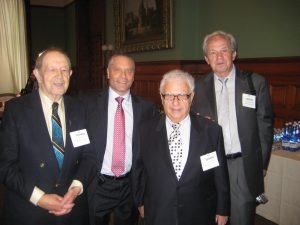When Art Spiegelman’s Maus first appeared in book form in 1986, it received its share of criticism before general opinion – and the Pulitzer Prize – confirmed that a personal story associated with the Holocaust could be told in a form that resembled comic book art.
Spiegelman made important changes to the genre before completing Maus. These came in part from his involvement in what was known as the underground COMIX culture of New York City and Berkeley, where young illustrators broke with longstanding trends in American comic book storytelling and design.
Spiegelman’s early work highlighted the artist’s personal stories; it made use of a novelistic narrative voice that guides the reader; he chose black and white drawings over colour; and he abandoned the heightened action sequences beloved of superhero comics.
The graphic novel, a more or less new genre, had arrived, and the events of the Holocaust had acquired a new kind of art to represent them.
It wasn’t Spiegelman’s goal in using graphics to tell his father’s story to aid in bringing young readers to Maus. This goal has, though, motivated many later projects by other authors, who present Holocaust stories in graphic form in order to educate while entertaining. Among the best of these is Karski’s Mission to Stop the Holocaust, a comic book conceived as a teaching aid, whose creative and historical methods make it worthy of Maus’s example.
Karski’s Mission to Stop the Holocaust is written by Rafael Medoff, the founding director of the David S. Wyman Institute for Holocaust Studies in Washington, D.C. Medoff is a scholar of Holocaust history and the creator of other Holocaust-related graphic projects. The illustrator of Karski’s Mission is Dean Motter, a first-rate contemporary artist who has designed avant-garde work for Terminal City as well as more popular comic titles that include Batman and Wolverine.
READ: POLAND IN THE SUMMER OF NEW DISCONTENTS
Jan Karski is little known in North America. Like a number of other key non-Jewish Poles whose wartime activities should be a part of our everyday knowledge, his story has not gained its deserved profile.
Karski’s Mission to Stop the Holocaust approaches its story with energy and concision, opening cinematically with Karski’s escape in late 1939 from a German POW train. By way of flashbacks it reverts to Karski’s youth in multicultural Lodz. In Karski’s case, the large Jewish population in his city, along with his mother’s religious idealism, led to a belief in the new Polish state as a protector of individual rights.
At Lviv University, where he studied diplomacy and the law of nations, Karski witnessed the discriminatory “ghetto benches” for Jewish students, as well as faculty who did not abide by such rules and called their Jewish students to take seats at the front of the class.
The outbreak of war coincided with Karski’s early years in Poland’s diplomatic service. With the fall of Warsaw he followed his brother into the Polish Underground Resistance.
Karski’s Mission to Stop the Holocaust approaches these events in a style reminiscent of early comic book art and its recent revival under uniquely stylish artists. Its pages are framed in haunting greys and midnight blues, with illustrations reminiscent of film noir. In this, Karski’s Mission to Stop the Holocaust is more like a traditional comic book than Maus in its presentation, while sharing the goal of capturing a personal voice to tell difficult history.
The activities for which Karski is best known began in the summer of 1942, as the Germans emptied the Warsaw Ghetto of its population and greatly increased the pace of killing at Treblinka and Auschwitz.
Karski twice entered the Warsaw Ghetto in this period to witness what was being done there and to meet leading Jewish figures. He travelled, in the disguise of an Estonian guard, to the outskirts of a “transit camp” at Izbica Lubelska. There he witnessed the brutal redirecting of Jews to the death camps at Sobibor and Belzec.
After these encounters he crossed Europe, then travelled by boat to England where, as a representative of the Polish Government-in-Exile, he met with British officials, Jewish leaders and journalists. With him, on microfilm hidden inside a key, came his report titled The Mass Extermination of Jews in German Occupied Poland. It had little impact in Britain. Prime Minister Winston Churchill would not see Karski, and Foreign Minister Anthony Eden was non-committal.
By the summer of 1943, Karski was in Washington undertaking a similar struggle to meet with key figures in the U.S. government. Supreme Court Justice Felix Frankfurter, himself a Jew, did not find Karski believable. And though President Franklin Roosevelt met with him, the encounter brought about no change in American or Allied response to the murder of European Jews. As Karski’s Mission has its hero put it: “I had failed at diplomacy.”
In 1944 Karski published, to great acclaim, Story of a Secret State, which described the organization and activities of the Polish Underground. The book’s popularity led to a cross-country lecture tour focused on the state of war in Poland.
At war’s end Karski’s last mission, prompted by a request from ex-U.S. president Herbert Hoover, was to recover the records of the Polish Government-in-Exile before the full takeover of Poland by Stalinist Russia.
Karski spent the rest of his life in America. He earned a Ph.D., married Polish-born Jewish dancer Pola Nirenska, and taught at Georgetown University’s School of Foreign Service. In a telling frame late in Karski’s Mission to Stop the Holocaust, its authors picture Karski’s students after hearing him lecture on the Warsaw Ghetto. “Was that for real?” one wonders, while the other asks, “Could he be making that up?”
Karski’s Mission to Stop the Holocaust is among the best examples since the appearance of Maus of what can be done with the comic book genre to confront the Holocaust.






